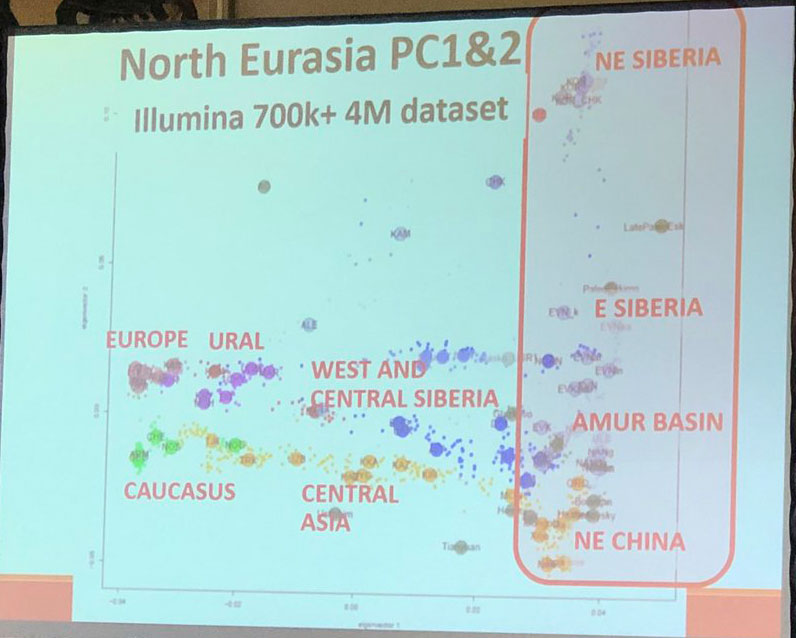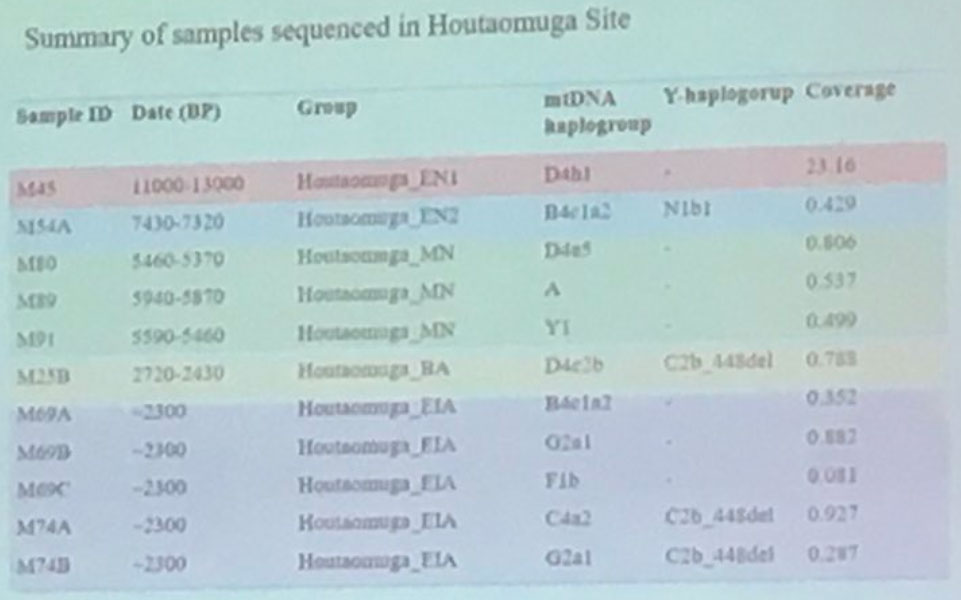Some information is already available from ISBA 8 (see programme in PDF), thanks to the tweets from Alexander M. Kim.
Official abstracts are listed first (emphasis mine), then reports and images with link to Kim’s tweets. Here is the list for quick access:
- Turkic and Hunnic expansions
- Central Asia and Indo-Iranian
- British Isles
- MN Atlantic / Megalithic cultures
- Central European Bronze Age
Updates (17:00 CET):
- Finland AD 5th-8th c.
- Russian Far East populations
- Dairying in ancient Mongolia
- Neolithic transition in Northeast Asia
Turkic and Hunnic expansions
Tracing the origin and expansion of the Turkic and Hunnic confederations, by Flegontov et al.
Turkic-speaking populations, now spread over a vast area in Asia, are highly heterogeneous genetically. The first confederation unequivocally attributed to them was established by the Göktürks in the 6th c. CE. Notwithstanding written resources from neighboring sedentary societies such as Chinese, Persian, Indian and Eastern Roman, earlier history of the Turkic speakers remains debatable, including their potential connections to the Xiongnu and Huns, which dominated the Eurasian steppe in the first half of the 1st millennium CE. To answer these questions, we co-analyzed newly generated human genome-wide data from Central Asia (the 1240K panel), spanning the period from ca. 3000 to 500 YBP, and the data published by de Barros Damgaard et al. (137 ancient human genomes from across the Eurasian steppes, Nature, 2018). Firstly, we generated a PCA projection to understand genetic affinities of ancient individuals with respect to present-day Tungusic, Mongolic, Turkic, Uralic, and Yeniseian-speaking groups. Secondly, we modeled hundreds of present-day and few ancient Turkic individuals using the qpAdm tool, testing various modern/ancient Siberian and ancient West Eurasian proxies for ancestry sources.
A majority of Turkic speakers in Central Asia, Siberia and further to the west share the same ancestry profile, being a mixture of Tungusic or Mongolic speakers and genetically West Eurasian populations of Central Asia in the early 1st millennium CE. The latter are themselves modelled as a mixture of Iron Age nomads (western Scythians or Sarmatians) and ancient Caucasians or Iranian farmers. For some Turkic groups in the Urals and the Altai regions and in the Volga basin, a different admixture model fits the data: the same West Eurasian source + Uralic- or Yeniseian-speaking Siberians. Thus, we have revealed an admixture cline between Scythians and the Iranian farmer genetic cluster, and two further clines connecting the former cline to distinct ancestry sources in Siberia. Interestingly, few Wusun-period individuals harbor substantial Uralic/Yeniseian-related Siberian ancestry, in contrast to preceding Scythians and later Turkic groups characterized by the Tungusic/Mongolic-related ancestry. It remains to be elucidated whether this genetic influx reflects contacts with the Xiongnu confederacy. We are currently assembling a collection of samples across the Eurasian steppe for a detailed genetic investigation of the Hunnic confederacies.
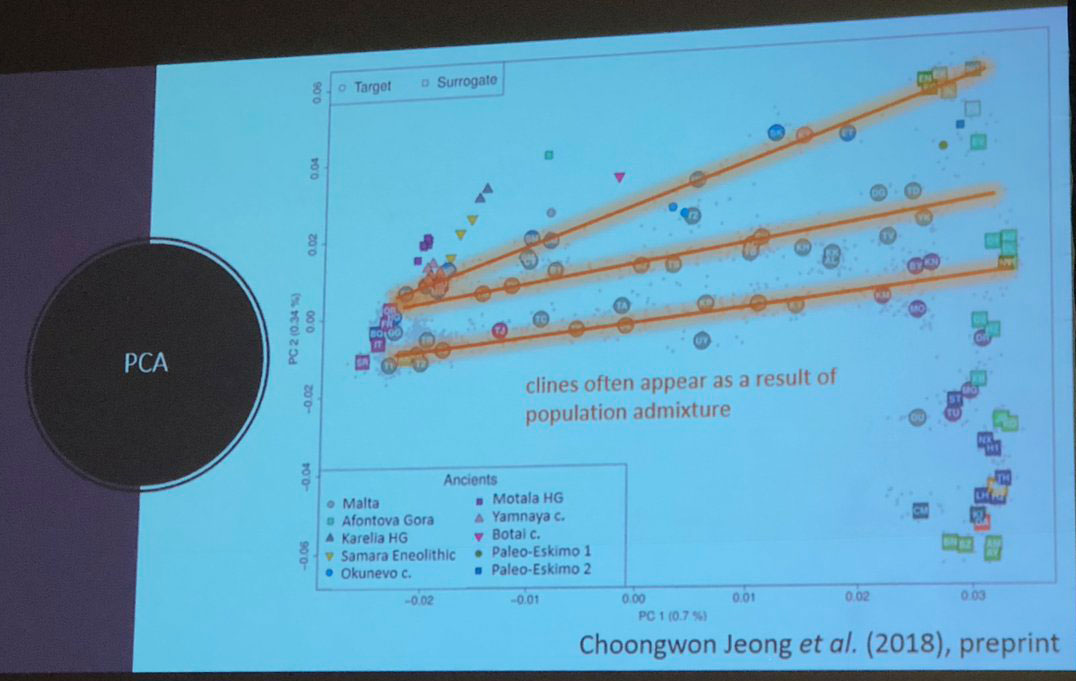
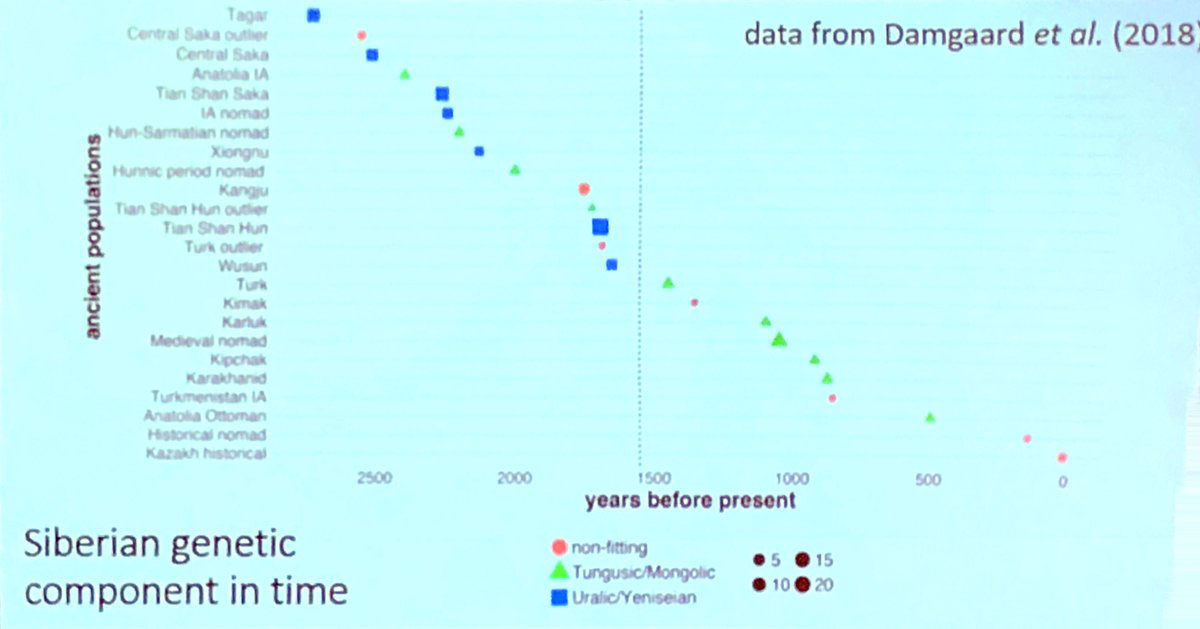
Flegontov: Present day Turkic speakers fall into two clusters of admixture patterns (Uralic/Yenisean and Tungussic/Mngolic) based on genomic data with ancient Turks belonging almost exclusively to the first cluster. #ISBA8
— StoneLab_ASU (@StoneLab_ASU) September 19, 2018
New interesting information on the gradual arrival of the “Uralic-Yeniseian” (Siberian) ancestry in eastern Europe with Iranian and Turkic-speaking peoples. We already knew that Siberian ancestry shows no original relationship with Uralic-speaking peoples, so to keep finding groups who expanded this ancestry eastwards in North Eurasia should be no surprise for anyone at this point.
Central Asia and Indo-Iranian
The session The Genomic Formation of South and Central Asia, by David Reich, on the recent paper by Narasimhan et al. (2018).
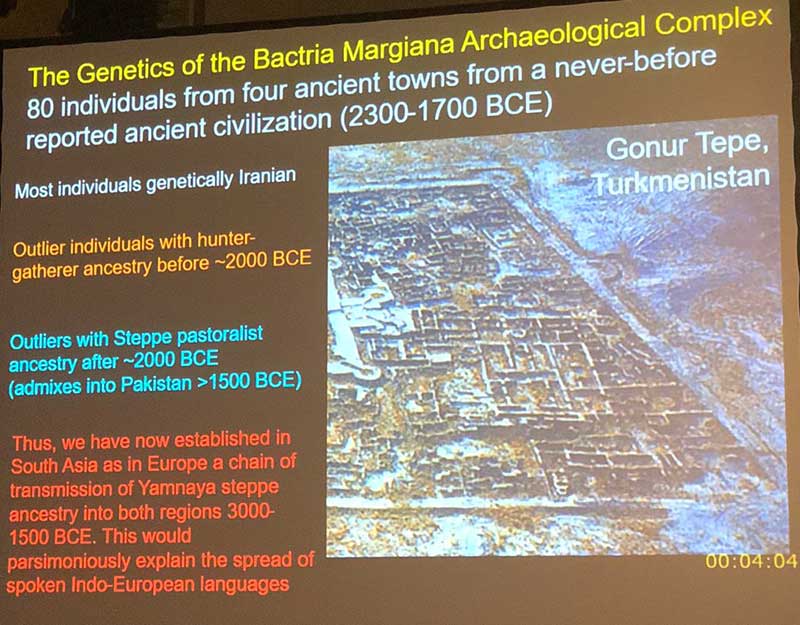
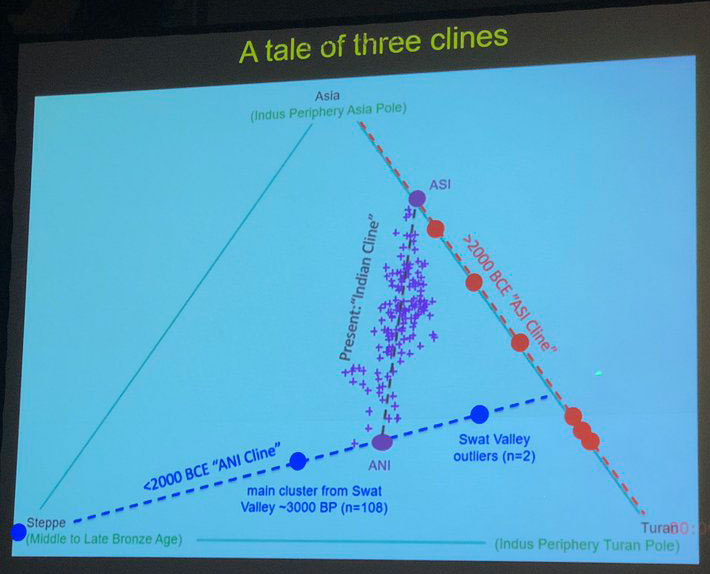
– Some more certainty about primary window of steppe ancestry injection into S. Asia: 2000-1500 BC
Alexander M. Kim
Very refreshing this morning to hear a senior academic say “we were wrong” – David Reich @Harvard on the genomics of South + Central Asia (with some highly problematic terminology!) #ISBA8 @MPI_SHH #genomics #archsci #indus #archaeogenetics pic.twitter.com/26Zez21VNE
— Samantha Leggett (@samleggs22) September 19, 2018
British Isles
Ancient DNA and the peopling of the British Isles – pattern and process of the Neolithic transition, by Brace et al.
Over recent years, DNA projects on ancient humans have flourished and large genomic-scale datasets have been generated from across the globe. Here, the focus will be on the British Isles and applying aDNA to address the relative roles of migration, admixture and acculturation, with a specific focus on the transition from a Mesolithic hunter-gatherer society to the Neolithic and farming. Neolithic cultures first appear in Britain ca. 6000 years ago (kBP), a millennium after they appear in adjacent areas of northwestern continental Europe. However, in Britain, at the margins of the expansion the pattern and process of the British Neolithic transition remains unclear. To examine this we present genome-wide data from British Mesolithic and Neolithic individuals spanning the Neolithic transition. These data indicate population continuity through the British Mesolithic but discontinuity after the Neolithic transition, c.6000 BP. These results provide overwhelming support for agriculture being introduced to Britain primarily by incoming continental farmers, with surprisingly little evidence for local admixture. We find genetic affinity between British and Iberian Neolithic populations indicating that British Neolithic people derived much of their ancestry from Anatolian farmers who originally followed the Mediterranean route of dispersal and likely entered Britain from northwestern mainland Europe.
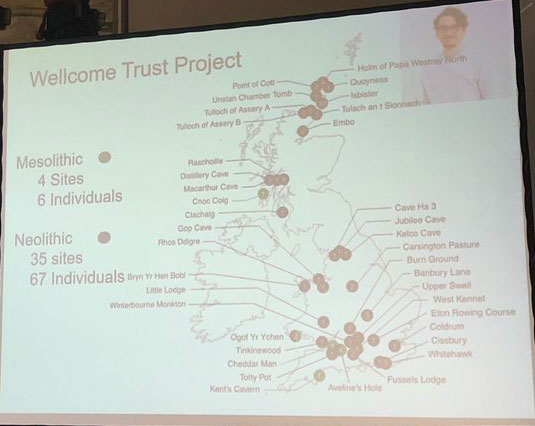

– Argument for at least two geographically distinct entries of Neolithic farmers
Alexander M. Kim.
MN Atlantic / Megalithic cultures
Genomics of Middle Neolithic farmers at the fringe of Europe, by Sánchez Quinto et al.
Agriculture emerged in the Fertile Crescent around 11,000 years before present (BP) and then spread, reaching central Europe some 7,500 years ago (ya.) and eventually Scandinavia by 6,000 ya. Recent paleogenomic studies have shown that the spread of agriculture from the Fertile Crescent into Europe was due mainly to a demic process. Such event reshaped the genetic makeup of European populations since incoming farmers displaced and admixed with local hunter-gatherers. The Middle Neolithic period in Europe is characterized by such interaction, and this is a time where a resurgence of hunter-gatherer ancestry has been documented. While most research has been focused on the genetic origin and admixture dynamics with hunter-gatherers of farmers from Central Europe, the Iberian Peninsula, and Anatolia, data from farmers at the North-Western edges of Europe remains scarce. Here, we investigate genetic data from the Middle Neolithic from Ireland, Scotland, and Scandinavia and compare it to genomic data from hunter-gatherers, Early and Middle Neolithic farmers across Europe. We note affinities between the British Isles and Iberia, confirming previous reports. However, we add on to this subject by suggesting a regional origin for the Iberian farmers that putatively migrated to the British Isles. Moreover, we note some indications of particular interactions between Middle Neolithic Farmers of the British Isles and Scandinavia. Finally, our data together with that of previous publications allow us to achieve a better understanding of the interactions between farmers and hunter-gatherers at the northwestern fringe of Europe.

– “Megalithic” individuals not systematically diff. from geographically proximate “non-megalithic” burials
– Mild evidence for over-representation of males in some British Isles megalithic tombs
– Megalithic tombs in W & N Neolithic Europe may have link to kindred structures
Alexander M. Kim
Central European Bronze Age
Ancient genomes from the Lech Valley, Bavaria, suggest socially stratified households in the European Bronze Age, by Mittnik et al.
Archaeogenetic research has so far focused on supra-regional and long-term genetic developments in Central Europe, especially during the third millennium BC. However, detailed high-resolution studies of population dynamics in a microregional context can provide valuable insights into the social structure of prehistoric societies and the modes of cultural transition.
Here, we present the genomic analysis of 102 individuals from the Lech valley in southern Bavaria, Germany, which offers ideal conditions for such a study. Several burial sites containing rich archaeological material were directly dated to the second half of the 3rd and first half of the 2nd millennium BCE and were associated with the Final Neolithic Bell Beaker Complex and the Early and Middle Bronze Age. Strontium isotope data show that the inhabitants followed a strictly patrilocal residential system. We demonstrate the impact of the population movement that originated in the Pontic-Caspian steppe in the 3rd millennium BCE and subsequent local developments. Utilising relatedness inference methods developed for low-coverage modern DNA we reconstruct farmstead related pedigrees and find a strong association between relatedness and grave goods suggesting that social status is passed down within families. The co-presence of biologically related and unrelated individuals in every farmstead implies a socially stratified complex household in the Central European Bronze Age.
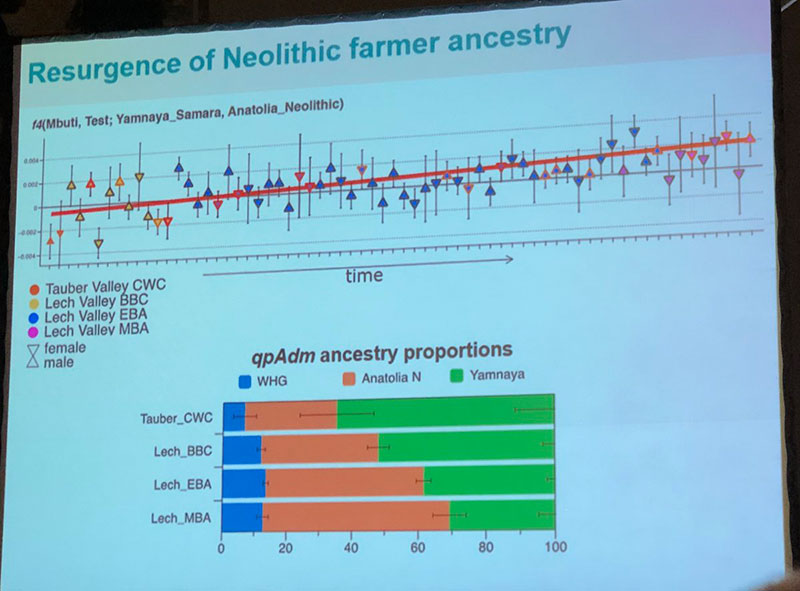
Alissa Mittnik of @MPI_SHH with a talk that heralds a new era of studying archaeological sites: using high resolution ancient DNA to reconstruct relatedness patterns—her results reveal patrilocality in Late Neolithic and Bronze Age Central Europe #isba8
— Pontus Skoglund (@pontus_skoglund) September 19, 2018
Notice how the arrival of Bell Beakers, obviously derived from Yamna settlers in Hungary, and thus clearly identified as expanding North-West Indo-Europeans all over Europe, marks a decrease in steppe ancestry compared to Corded Ware groups, in a site quite close to the most likely East BBC homeland. Copenhagen’s steppe ancestry = Indo-European going down the toilet, step by step…
UPDATES
Russian Far East populations
Gene geography of the Russian Far East populations – faces, genome-wide profiles, and Y-chromosomes, by Balanovsky et al.
Russian Far East is not only a remote area of Eurasia but also a link of the chain of Pacific coast regions, spanning from East Asia to Americas, and many prehistoric migrations are known along this chain. The Russian Far East is populated by numerous indigenous groups, speaking Tungusic, Turkic, Chukotko-Kamchatka, Eskimo-Aleut, and isolated languages. This linguistic and geographic variation opens question about the patterns of genetic variation in the region, which was significantly undersampled and received minor attention in the genetic literature to date. To fill in this gap we sampled Aleuts, Evenks, Evens, Itelmens, Kamchadals, Koryaks, Nanais, Negidals, Nivkhs, Orochi, Udegeis, Ulchi, and Yakuts. We also collected the demographic information of local populations, took physical anthropological photos, and measured the skin color. The photos resulted in the “synthetic portraits” of many studied groups, visualizing the main features of their faces.

Finland AD 5th-8th c.
Sadly, no information will be shared on the session A 1400-year transect of ancient DNA reveals recent genetic changes in the Finnish population, by Salmela et al. We will have to stick to the abstract:
Objectives: Our objective was to use aDNA to study the population history of Finland. For this aim, we sampled and sequenced 35 individuals from ten archaeological sites across southern Finland, representing a time transect from 5th to 18th century.
Methods: Following genomic DNA extraction and preparation of indexed libraries, the samples were enriched for 1,2 million genomewide SNPs using in-solution capture and sequenced on an Illumina HighSeq 4000 instrument. The sequence data were then compared to other ancient populations as well as modern Finns, their geographical neighbors and worldwide populations. Authenticity testing of the data as well as population history inference were based on standard computational methods for aDNA, such as principal component analysis and F statistics.
Results: Despite the relatively limited temporal depth of our sample set, we are able to see major genetic changes in the area, from the earliest sampled individuals – who closely resemble the present-day Saami population residing markedly further north – to the more recent ancient individuals who show increased affinity to the neighboring Circum-Baltic populations. Furthermore, the transition to the present-day population seems to involve yet another perturbation of the gene pool.
So, most likely then, in my opinion – although possibly Y-DNA will not be reported – Finns were in the Classical Antiquity period mostly R1a with secondary N1c in the Circum-Baltic region (similar to modern Estonians, as I wrote recently), while Saami were probably mostly a mix of R1a-Z282 and I1 in southern Finland. That’s what the first transition after the 5th c. probably reflects, the spread of Finns (with mainly N1c lineages) to the north, while the more recent transition shows probably the introduction of North Germanic ancestry (and thus also R1b-U106, R1a-Z284, and I1 lineages) in the west.
Dairying in ancient Mongolia
The History of Dairying in ancient Mongolia, by Wilkin et al.
The use of mass spectrometry based proteomics presents a novel method for investigating human dietary intake and subsistence strategies from archaeological materials. Studies of ancient proteins extracted from dental calculus, as well as other archaeological material, have robustly identified both animal and plant-based dietary components. Here we present a recent case study using shotgun proteomics to explore the range and diversity of dairying in the ancient eastern Eurasian steppe. Contemporary and prehistoric Mongolian populations are highly mobile and the ephemerality of temporarily occupied sites, combined with the severe wind deflation common across the steppes, means detecting evidence of subsistence can be challenging. To examine the time depth and geographic range of dairy use in Mongolia, proteins were extracted from ancient dental calculus from 32 individuals spanning burial sites across the country between the Neolithic and Mongol Empire. Our results provide direct evidence of early ruminant milk consumption across multiple time periods, as well as a dramatic increase in the consumption of horse milk in the late Bronze Age. These data provide evidence that dairy foods from multiple species were a key part of subsistence strategies in prehistoric Mongolia and add to our understanding of the importance of early pastoralism across the steppe.
Hypothesis: dairy pastoralism extends into Late #BronzeAge
– calculus samples from 31 individuals 3000 BC – AD 1400
– shotgun proteomics; liquid chromatography–mass spectrometry
– BLG peptides differentiate ruminant and equine milk, caprine-specific markers— Alexander M. Kim (@amwkim) September 19, 2018
– dairying began on eastern #steppe 1500 years before hypothesized dates: at least as early as 3000-2700 BC in Khangai and Altai
– shift to equine focus in LBA— Alexander M. Kim (@amwkim) September 19, 2018
The confirmation of the date 3000-2700 BC for dairying in the eastern steppe further supports what was already known thanks to archaeological remains, that the pastoralist subsistence economy was brought for the first time to the Altai region by expanding late Khvalynsk/Repin – Early Yamna pastoralists that gave rise to the Afanasevo culture.
Neolithic transition in Northeast Asia
Genomic insight into the Neolithic transition peopling of Northeast Asia, by C. Ning
East Asian representing a large geographic region where around one fifth of the world populations live, has been an interesting place for population genetic studies. In contrast to Western Eurasia, East Asia has so far received little attention despite agriculture here evolved differently from elsewhere around the globe. To date, only very limited genomic studies from East Asia had been published, the genetic history of East Asia is still largely unknown. In this study, we shotgun sequenced six hunter-gatherer individuals from Houtaomuga site in Jilin, Northeast China, dated from 12000 to 2300 BP and, 3 farming individuals from Banlashan site in Liaoning, Northeast China, dated around 5300 BP. We find a high level of genetic continuity within northeast Asia Amur River Basin as far back to 12000 BP, a region where populations are speaking Tungusic languages. We also find our Compared with Houtaomuga hunter-gatherers, the Neolithic farming population harbors a larger proportion of ancestry from Houtaomuga related hunter-gathers as well as genetic ancestry from central or perhaps southern China. Our finding further suggests that the introduction of farming technology into Northeast Asia was probably introduced through demic diffusion.
“Genomic insight into the peopling of Northeast China” – Chao Ning @MPI_SHH #ISBA8. Amazing genomic time transect 12000–2300BP from Houtaomuga, Jilin, PRC with #aDNA evidence for genetic continuity of #Tungusic-like groups in #Amur region even deeper than Chertovy Voroda (5700BC) pic.twitter.com/DGqibs52IE
— Alexander M. Kim (@amwkim) September 19, 2018
A detail of the reported haplogroups of the Houtaomuga site:
Y-DNA in Northeast Asia shows thus haplogroup N1b1 ~5000 BC, probably representative of the Baikal region, with a change to C2b-448del lineages before the Xiongnu period, which were later expanded by Mongols.
